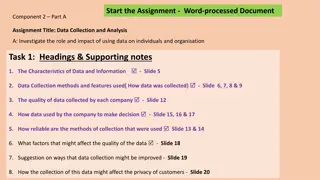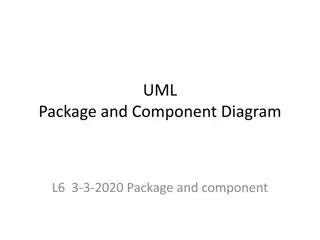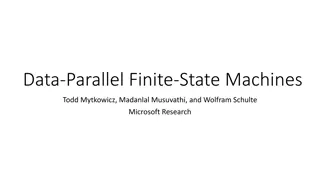Handling Auxiliary Tables in Reusable Components
Approach for managing auxiliary tables efficiently within main features using a data format response. Presentation details Plinio Prado's exploration of different alternatives and his experience in transitioning front-end to TypeScript after the project. The talk emphasizes making informed choices o
0 views • 22 slides
Understanding Input-Output Models in Economics
Input-Output models, pioneered by Wassily Leontief, depict inter-industry relationships within an economy. These models analyze the dependencies between different sectors and have been utilized for studying agricultural production distribution, economic development planning, and impact analysis of i
8 views • 7 slides
Revolutionizing with NLP Based Data Pipeline Tool
The integration of NLP into data pipelines represents a paradigm shift in data engineering, offering companies a powerful tool to reinvent their data workflows and unlock the full potential of their data. By automating data processing tasks, handling diverse data sources, and fostering a data-driven
9 views • 2 slides
Revolutionizing with NLP Based Data Pipeline Tool
The integration of NLP into data pipelines represents a paradigm shift in data engineering, offering companies a powerful tool to reinvent their data workflows and unlock the full potential of their data. By automating data processing tasks, handling diverse data sources, and fostering a data-driven
7 views • 2 slides
Localised Adaptive Spatial-Temporal Graph Neural Network
This paper introduces the Localised Adaptive Spatial-Temporal Graph Neural Network model, focusing on the importance of spatial-temporal data modeling in graph structures. The challenges of balancing spatial and temporal dependencies for accurate inference are addressed, along with the use of distri
3 views • 19 slides
Ask On Data for Efficient Data Wrangling in Data Engineering
In today's data-driven world, organizations rely on robust data engineering pipelines to collect, process, and analyze vast amounts of data efficiently. At the heart of these pipelines lies data wrangling, a critical process that involves cleaning, transforming, and preparing raw data for analysis.
2 views • 2 slides
Data Wrangling like Ask On Data Provides Accurate and Reliable Business Intelligence
In current data world, businesses thrive on their ability to harness and interpret vast amounts of data. This data, however, often comes in raw, unstructured forms, riddled with inconsistencies and errors. To transform this chaotic data into meaningful insights, organizations need robust data wrangl
0 views • 2 slides
Understanding Makefiles in Intermediate Programming
Makefiles are essential for automating the build process in programming projects by defining rules for building target files based on dependencies. By organizing commands and dependencies in a structured manner, Makefiles simplify the build process, reduce errors, and save time. This article covers
0 views • 18 slides
Understanding Database Normalization and Functional Dependencies
Database normalization is a crucial process that aims to improve database design by organizing data into higher forms of normality. This helps in reducing redundancy and ensuring data integrity. Functional dependencies play a key role in defining relationships between attributes in a database. By un
0 views • 33 slides
Effective Census Planning for Successful Population and Housing Censuses
Census planning is crucial for the success of population and housing censuses, involving phases like questionnaire design, mapping, testing, enumeration, and data analysis. The link between these phases plays a vital role in the overall success of the census operation. The aim of census planning is
0 views • 24 slides
Comprehensive RAID Log Presentation and Management Overview
This comprehensive presentation template provides a detailed overview of a RAID log, including risks, issues, threats, assumptions, dependencies, and reliance factors. It offers insights on tracking and managing different aspects of project planning and execution, categorized by risk levels. The bre
0 views • 6 slides
Understanding Data Governance and Data Analytics in Information Management
Data Governance and Data Analytics play crucial roles in transforming data into knowledge and insights for generating positive impacts on various operational systems. They help bring together disparate datasets to glean valuable insights and wisdom to drive informed decision-making. Managing data ma
0 views • 8 slides
Overview of Subprograms in Software Development
Subprograms in software development provide a means for abstraction and modularity, with characteristics like single entry points, suspension of calling entities, and return of control upon termination. They encompass procedures and functions, raising design considerations such as parameter passing
4 views • 25 slides
Implementing In-App Navigation with Jetpack's Architecture Components
Discover how to easily implement in-app navigation using Jetpack's Navigation components. Learn to create a navigation graph, connect fragments, pass data, and set up your project efficiently. Check out essential steps like setting up dependencies, creating the navigation graph, and transitioning be
2 views • 16 slides
Understanding the MECE Framework for Efficient Problem-Solving
The MECE (Mutually Exclusive, Collectively Exhaustive) framework is a powerful tool used by business leaders and consultants like McKinsey to structure information, reduce complexity, and gather comprehensive data without overlaps. It involves creating issue trees that subdivide problem elements int
1 views • 4 slides
Understanding the Impact of Dirty Data on Quality Improvement
Real-world data often contains errors and inconsistencies, leading to significant costs for businesses. Research activities focus on error correction, object identification, profiling, and data integration to enhance data quality. A principled approach based on data dependencies offers a promising s
0 views • 53 slides
Provenance Analysis of Algorithms - Understanding Data Dependencies
Exploring the concept of provenance analysis in algorithms to understand how output items depend on input items. This analysis goes beyond traditional activity logs, focusing on structured collections of items and exploring various applications for causal and quantitative analysis. The critical test
1 views • 16 slides
Understanding Data Collection and Analysis for Businesses
Explore the impact and role of data utilization in organizations through the investigation of data collection methods, data quality, decision-making processes, reliability of collection methods, factors affecting data quality, and privacy considerations. Two scenarios are presented: data collection
1 views • 24 slides
Understanding Dynamic Rank Frameworks in Lucene/Solr
Explore the complexities of dynamic ranking in Lucene/Solr through various strategies such as static ranks, multiple field types, and dynamic score queries. Dive into the nuances of combining scores, Boolean operations, and the intricate dependencies between queries and data to enhance search releva
0 views • 49 slides
Exploring the Elsinore 2023 D08 Using Packages by Morten Kromberg
In Elsinore 2023 D08, Morten Kromberg introduces the usage of various packages through a series of operations. Starting from checking if the world is destroyed to setting up mail access and running demos, the content covers a range of activities. The narrative delves into accessing and manipulating
0 views • 42 slides
Comprehensive RAID Log Presentation Template
This comprehensive presentation template includes a RAID log with risks, assumptions, issues, and dependencies structured in a professional layout. Utilize this template to effectively manage project risks and dependencies. The template also features a simple RAID log slide template for a clear over
0 views • 7 slides
Understanding Data Dependencies in Nested Loops
Studying data dependencies in nested loops is crucial for optimizing code performance. The analysis involves assessing dependencies across loop iterations, iteration numbers, iteration vectors, and loop nests. Dependencies in loop nests are determined by iteration vectors, memory accesses, and write
0 views • 15 slides
Epochwise Back Propagation Through Time for Recurrent Networks
In the context of training recurrent networks, Epochwise Back Propagation Through Time involves dividing the data set into independent epochs, each representing a specific temporal pattern of interest. The start time of each epoch, denoted by 'no', is crucial for capturing the sequential dependencie
0 views • 28 slides
Analysis of Deep Learning Models for EEG Data Processing
This content delves into the application of deep learning models, such as Sequential Modeler, Feature Extraction, and Discriminator, for processing EEG data from the TUH EEG Corpus. The architecture involves various layers like Convolution, Max Pooling, ReLU activation, and Dropout. It explores temp
0 views • 15 slides
Statistical Dependencies in Sparse Representations: Exploitation & Applications
Explore how to exploit statistical dependencies in sparse representations through joint work by Michael Elad, Tomer Faktor, and Yonina Eldar. The research delves into practical pursuit algorithms using the Boltzmann Machine, highlighting motivations, basics, and practical steps for adaptive recovery
0 views • 47 slides
Understanding UML Package Diagrams and Components in Software Design
UML package diagrams are essential in organizing model elements such as use cases and classes into groups for a better structure in system modeling. They help in providing a high-level overview of requirements and architecture, logically modularizing complex diagrams, and indicating dependencies bet
0 views • 38 slides
Data-Parallel Finite-State Machines: A Breakthrough Approach
This research discusses a new method for breaking data dependencies in data-parallel finite-state machines. It highlights the importance of FSMs in various algorithms and the need for parallel versions in processing large data sets. The study explores breaking data dependences with enumeration and t
0 views • 19 slides
Understanding Recurrent Neural Networks: Fundamentals and Applications
Explore the realm of Recurrent Neural Networks (RNNs), including Long Short-Term Memory (LSTM) models and sequence-to-sequence architectures. Delve into backpropagation through time, vanishing/exploding gradients, and the importance of modeling sequences for various applications. Discover why RNNs o
0 views • 102 slides
Radon Concentrations in New-Built Swedish Dwellings: Findings from International Radon Symposium
Large decrease in radon concentrations observed in newly built Swedish dwellings, with data analyzed from 1950 to 2016. Dependencies between building year, foundation type, ventilation, and radon levels were evaluated. Results compared against the Swedish reference level of 200 Bq/m3. Measurements i
0 views • 14 slides
Understanding Latency in JESD204B Links
Latency in a JESD204B link refers to the time it takes for a signal to travel from input to output, influenced by factors like system setup, device dependencies, clock propagation delays, and signal alignment. Definitions such as Sample-to-Serial Out (S2SO), Link Delay, and Link Latency are crucial
0 views • 46 slides
Understanding Pipeline Hazards in Computer Architecture
Pipeline hazards in computer architecture are classified into three categories: structural, data, and control hazards. Structural hazards occur due to conflicts in hardware resources, data hazards stem from dependencies between instructions, and control hazards arise from branching instructions. The
0 views • 42 slides
Exploring Project Modelling and Work Breakdown Structures
In project management, precise project definition is crucial for successful planning and control. Project modelling involves utilizing tools like Work Breakdown Structure (WBS) to efficiently define project scopes and hierarchies. By breaking down the project into smaller elements of work, WBS aids
0 views • 37 slides
Enhancing Robot Control in Neurosurgery through Force Sensing Integration
The project aims to improve the cooperative control of the Galen robot in neurosurgery by measuring and integrating tool-to-tissue forces. By sensing these forces, the system can enhance visual feedback, establish safety limits, evaluate surgical skills, and allow unbiased comparisons of techniques.
0 views • 12 slides
Efficient and Effective Duplicate Detection in Hierarchical Data
This study explores the efficient and effective detection of duplicates in hierarchical data, focusing on fuzzy duplicates and hierarchical relationships in XML. It discusses the current and proposed systems, including the use of Bayesian networks for similarity computations. The methods involve vec
0 views • 25 slides
Kinematic Analysis of Complex Mechanisms Using SAM
Kinematic analysis of mechanisms using SAM software tools is essential in machine engineering. Designing machines and mechanisms starts by considering kinematics to investigate motion dependencies. This process involves synthesis and analysis phases, using tools like SAM, SolidWorks, and Autodesk In
0 views • 17 slides
Loop Invariant Code Motion in Frequent Paths for Optimization
Loop Invariant Code Motion (LICM) is a key optimization technique that identifies and moves code operations whose operands remain constant within a loop to improve performance. The process involves careful consideration of memory operations and operations not executed every iteration. The assignment
0 views • 20 slides
Forecasting Short-Term Urban Rail Passenger Flows Using Dynamic Bayesian Networks
A study presented a dynamic Bayesian network approach to forecast short-term urban rail passenger flows in the Paris region. The research addresses the challenges of incomplete data, unexpected events, and the need for real-time forecasting in public transport networks. By leveraging Bayesian networ
0 views • 19 slides
Understanding Three-Phase Relative Permeabilities in Reservoir Engineering
Explore the application, correlations, and traditional assumptions of three-phase relative permeabilities in reservoir engineering. Learn about saturation-dependencies, occupancy models, and the challenges of measuring three-phase relative permeabilities. Discover how to calculate three-phase permea
0 views • 14 slides
Database Design Principles Overview
Explore the fundamental concepts of designing a database, covering topics such as decomposition, functional dependencies, closures, and canonical cover. Understand the importance of avoiding redundancies and anomalies in database design while striving for lossless-join and dependency-preserving deco
0 views • 35 slides
Trade-offs in Floating Point Accumulation: Balancing Accuracy, Cost, and Performance
When designing floating point accumulation systems, achieving high throughput and accuracy presents a challenging trade-off. Inconsistent accuracy due to data dependencies can lead to significant errors in results. Strategies such as compensated summation or using extended precision adders can help
0 views • 11 slides







































